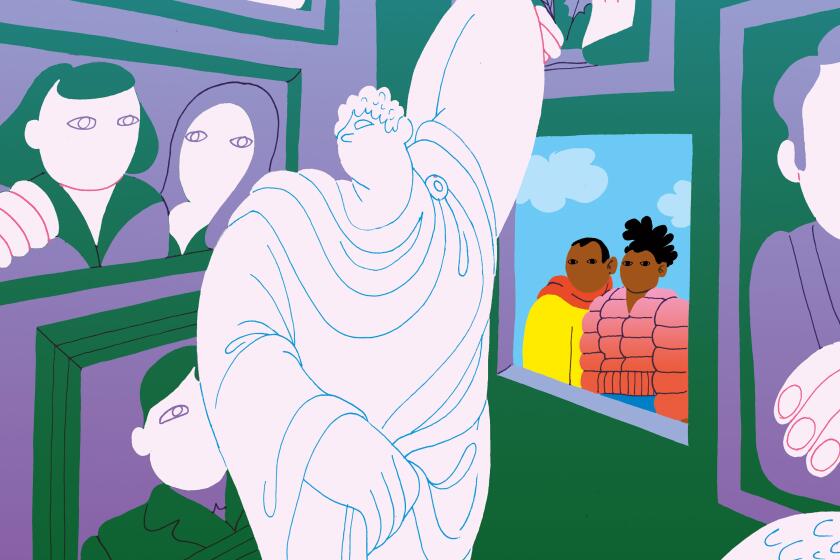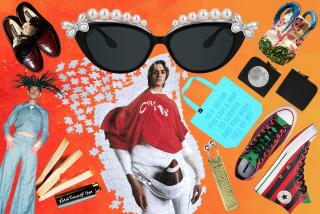‘Made in L.A.’ biennial art has been on view for weeks. You just didn’t know it
It doesn’t exactly seem like a momentous morning at Bloom & Plume Coffee in Historic Filipinotown: Customers linger on the sidewalk awaiting shots of espresso and oat milk lattes to go, as the K-pop girl group Blackpink spills from the café’s speakers.
Unbeknownst to many of the customers moving through morning routines, they are attending one of the city’s most anticipated art events of 2020. Silent video footage on two TV screens is part of a multisite art installation in the Hammer Museum’s “Made in L.A.” biennial.
The images that make up artist Kahlil Joseph’s “BLKNWS®” flash across the screens with urgency. A Goldilocks illustration appears opposite the text, “The first example of white privilege you learn about.” “Vice News Tonight” correspondent Alzo Slade appears in conversation with the Museum of Contemporary Art’s former chief curator, Helen Molesworth, on both screens. Then one screen goes dark, and a rapid-succession of social media posts and web news headlines consumes the other.
But none of the customers seem aware that they are taking in a museum exhibition, which quietly debuted here two weeks ago.
The opening date for “Made in L.A. 2020: a version,” the biennial that this year takes place at the Hammer Museum in Westwood and the Huntington Library, Art Museum and Botanical Gardens in San Marino, has been in limbo since the museums closed in March. The free exhibition, which spotlights 30 mostly emerging local artists, moved its opening from June to September, but that wasn’t enough of a delay for the coronavirus. The opening date is still in question as the museums await guidelines from state and health officials.
But several outdoor public art installations included in the biennial have quietly opened.
“We were waiting for more of the projects to be installed before we invited people to experience them,” Hammer Museum representative Nancy Lee said. “Six ‘BLKNWS®’ sites are up now, and there are more coming.”
“BLKNWS®” (pronounced “Black news”) weaves original video footage, found film clips, music videos, social media posts, academic lectures and other imagery. It appears at Bloom & Plume, Patria Coffee Roasters in Compton, Natraliart Jamaican Restaurant in Arlington Heights, Go Get Em Tiger in Highland Park, Sole Folks in Leimert Park and Hank’s Mini Market in South L.A.
The installation, co-produced with the public art nonprofit Los Angeles Nomadic Division, purposefully appears where people naturally congregate and where they will stumble on the footage unexpectedly, without any wall text explaining it. Through this accidental viewing, the work is meant to challenge the idea of who has authority to decide what constitutes news.
“It creates a framework that’s recognizable, that’s familiar like the news,” said co-curator Lauren Mackler, “and it upends that by having content that’s a counternarrative to what’s normally in the news.”
Mackler and co-curator Myriam Ben Salah originally envisioned “BLKNWS®” appearing on 1,000 screens across the city, a conceptual gesture to how an artwork can employ pop culture to distribute ideas to a mass audience, as if it were a Hollywood film. But that was logistically challenging, even prior to COVID. When the pandemic hit, they pared back the scope, making the installation more intimate, which ultimately gave it a different kind of power.
“We originally thought: ‘Let’s make it this sweep across the city,’” Mackler said. “And where we landed, with these fewer pointed sites, is that it has become so much more about community at a time when community is changing, scarce and much needed.”
Joseph, who declined to be interviewed, is cofounder of L.A.’s Underground Museum, and he focused on public gathering spaces that were connected to the museum as well as Black-owned businesses and sites in Black communities, said the Hammer’s assistant curator of performance, Ikechukwu Onyewuenyi. Or in one case, a counterintuitive neighborhood.
Much more than simply increasing diversity, the task ahead will consist of rethinking the very ways in which museums are governed.
“Initially, Lauren, Myriam and I were perplexed by Kahlil’s insistence on Go Get Em Tiger. It’s in a strip in Highland Park that’s somewhat gentrified,” Onyewuenyi said. “But I think Kahlil was trying to be mindful of this largely white audience and how ‘BLKNWS®’ in that space could serve as a way to re-educate communities about marginal histories that may not be immediately apparent as the neighborhood changed.”
Since being installed at Bloom & Plume, where it hangs opposite a neon artwork depicting a raised fist gripping a blooming rose, “BLKNWS®” has had a quiet but important presence, even if viewers aren’t always aware it’s art, said co-owner Maurice Harris.
“People love it, they’re curious about it,” Harris said. “It’s such a powerful piece because it’s documenting parts of history but also current events and paralleling them in a very beautiful and creative way. The side-by-side screens and how they’re in conversation, it naturally draws people in.”
A second component of the Hammer biennial, artist Larry Johnson’s billboards, also is live. The project, co-produced with the nonprofit Billboard Creative, places five works on commercial billboards in the MacArthur Park area (addresses on the Hammer and Huntington websites). They’re all viewable to the public — if people can find them, which is part of the fun. The works feature text and images that riff on their surroundings, which are often bustling urban intersections brimming with other signage.
Johnson, who studied at the California Institute of the Arts and was influenced by the late artist and teacher John Baldessari, has deep connections to MacArthur Park: CalArts was located nearby when it was founded in 1921 as the Chouinard Art Institute. So the works are very much about the neighborhood.
“It draws attention to the sites itself, and the artist,” Onyewuenyi said. “And as you go looking with a curious mind, you start digging into: What is the history of this place?”
Many of the billboards are self-referential and humorous. One, called “Notary,” has an arrow pointing down toward an artist’s studio where a friend of Johnson’s works. That the artwork fills an advertising space is another layer: Johnson is, in a sense, creating an ad for his friend, who makes his living as a notary.
The Hammer’s fifth biennial was meant to be a cross-town art conversation with all participants showing work at both museums. But in the COVID-era, much of the planned content is actually taking place in spaces between the two institutions.
Justen LeRoy, who works under the name SON, is launching a biweekly podcast addressing Black male identity. The first episode, premiering “soon,” the museum said in its Thursday announcement, features LeRoy in conversation with author-activist Darnell Moore and filmmaker-entrepreneur Curtis Taylor Jr. Hip-hop producer Slauson Malone created the podcast’s soundscape.
Most of the performances in the biennial will now take place virtually and will roll out, incrementally, once the exhibition has fully opened at the museums.
“The biennial’s ready and it feels timely and we’re excited to share it,” Mackler said. “We’re thrilled, honestly, that there’s stuff up now that people can come see safely.”
A fiscally robust museum plans to fund operations by selling $73 million of its art. The scope of the move threatens to accelerate a troubling trend.
More to Read
The biggest entertainment stories
Get our big stories about Hollywood, film, television, music, arts, culture and more right in your inbox as soon as they publish.
You may occasionally receive promotional content from the Los Angeles Times.








